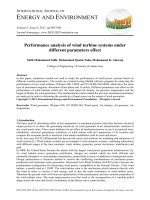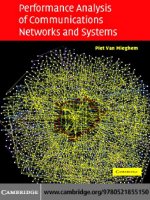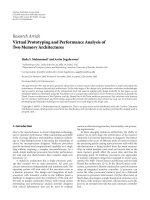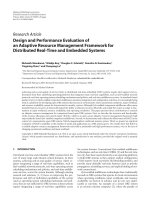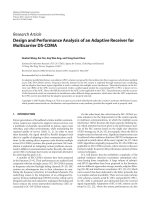Design and performance analysis of efficient wireless systems
Bạn đang xem bản rút gọn của tài liệu. Xem và tải ngay bản đầy đủ của tài liệu tại đây (1.46 MB, 195 trang )
DESIGN AND PERFORMANCE ANALYSIS OF
EFFICIENT WIRELESS SYSTEMS
WANG PEIJIE
NATIONAL UNIVERSITY OF SINGAPORE
2011
DESIGN AND PERFORMANCE ANALYSIS OF
EFFICIENT WIRELESS SYSTEMS
WANG PEIJIE
(M.Sc., National University of Singapore)
A THESIS SUBMITTED
FOR THE DEGREE OF DOCTOR OF PHILOSOPHY
DEPARTMENT OF ELECTRICAL AND COMPUTER
ENGINEERING
NATIONAL UNIVERSITY OF SINGAPORE
2011
Dedications:
To my family
Acknowledgment
It is my great pleasure to take this opportunity to express my sincere thanks to
everyone who has supported me during my PhD study.
First and foremost, my utmost gratitude and appreciation go to my supervisor,
Professor Kam Pooi-Yuen for his encouragement, guidance and support in all aspects
of my research working. I am deeply stimulated by his enthusiasm and expertise on
scientific research. It has been a great honor for me to work under his supervision
throughout the past four years. Those precious working experiences with him and
knowledge he has taught me, are the priceless treasures enriching my life.
My sincere thanks also go to my colleagues in the ECE-I2R Wireless
Communications Lab for their warm friendship. I would like to give my special
and grateful thanks to Wu Mingwei and Cao Le for their stimulating discussions
in research. Many thanks go to Zhu Yonglan, Lin Xuzheng, Yuan Haifeng, Zhang
Jianwen, Kang Xin, Chen Qian, He Jun, Jiang Jinhua and Siow Hong Lin, Eric.
I am grateful to Ghasem Naddaf, Dong Xiangxu, Han Mingding, Eu Zhi Ang
and Prof. Tham Chen-Khong, for producing works together.
I also would like to thank my friends, Li Lin, Peng Yafeng, Zhang Hao and Li
Ti, who have made my life enjoyable and always full of interesting things.
I am forever indebted to my parents for their endless love and support. Last
but not least, I owe my deepest gratitude to my girlfriend Liang Xi. Her love and
support lead me to where I am today.
Finally, the support of Singapore MoE AcRF Tier 2 Grant
T206B2101 in the form of a research scholarship is gratefully
i
Acknowledgment
acknowledged.
ii
Contents
Acknowledgment i
Contents iii
Summary viii
List of Tables x
List of Figures xi
Abbreviations xv
Notations xvii
Chapter 1. Introduction 1
1.1 MotivationoftheWork 5
1.1.1 FeedbackPowerControl 5
1.1.2 Receiver Design and Performance Analysis of DF Relay
Communication Systems 7
1.1.3 FastAdaptiveAlgorithmforCSIAcquisition 9
1.2 Main Results and Contributions 11
1.2.1 FeedbackPowerControl 11
1.2.2 Receiver Design and Performance Analysis of DF Relay
Communication Systems 13
1.2.3 FastAdaptiveAlgorithmforCSIAcquisition 17
iii
Contents
1.3 OrganizationoftheThesis 18
Chapter 2. Literature Review 19
2.1 Feedback Communications over Fading Channels 19
2.1.1 InformationTheoreticResults 20
2.1.2 FeedbackPowerControlinPracticalSystems 21
2.2 Relay Communication Systems 22
2.2.1 Relaying Protocols and Performance Analysis Issues 22
2.2.2 Receiver Design for DF Relay Systems 24
2.2.3 PerformanceAnalysisofDFRelaySystems 25
2.2.4 Multiple Relay Systems with Imperfect CSI 27
2.3 LMS Adaptive Filters 28
2.3.1 Wiener Filter 28
2.3.2 TheLMSandtheNLMSAlgorithms 29
2.3.3 VariableStep-SizeAlgorithms 31
Chapter 3. Feedback Power Control for the Rayleigh Channel 33
3.1 Introduction 34
3.2 SystemModel 35
3.2.1 Perfect CSI 36
3.2.2 Imperfect CSI 36
3.2.3 ChannelEstimationandPredictionusingPilots 37
3.3 BEP and BEOP of A Feedback System with Perfect CSI 44
3.4 ABEP-based Power Control with Perfect CSI 45
3.4.1 DesignofthePowerLaw 45
3.4.2 PerformanceAnalysis 47
3.5 BEOP-based Power Control with Perfect CSI 48
3.5.1 FormulationofthePowerLaw 49
3.5.2 ABEPAnalysis 50
3.6 BEP and BEOP of A Feedback System with Imperfect CSI 52
iv
Contents
3.7 ABEP-based Power Control with Imperfect CSI 53
3.7.1 Approximation 1 54
3.7.2 Approximation 2 57
3.8 BEOP-based Power Control with Imperfect CSI 59
3.8.1 FormulationofthePowerLaw 60
3.8.2 ABEPandBEOPAnalysis 61
3.9 Numerical Results 62
3.9.1 Performance under Perfect CSI . 62
3.9.2 Performance under Imperfect CSI . 68
3.10Conclusions 76
Chapter 4. Receiver Design of DF Relay Communication Systems 78
4.1 Introduction 79
4.2 SystemModel 81
4.2.1 ChannelModel 82
4.2.2 ChannelEstimation 83
4.3 ML Detector at the Destination for A DF Relay System with
Imperfect CSI 84
4.3.1 Detection at the r-thRelay 84
4.3.2 DetectionattheDestination 85
4.4 MLdetectorwithBPSK 88
4.5 Approximations to the ML Detector with BPSK 91
4.5.1 TheTraditionalMRC 91
4.5.2 TheWSD 92
4.5.3 TheCWSD 93
4.5.4 ThePLDetector 94
4.6 Conclusions 94
Chapter 5. Performance Analysis of A DF Relay System with BPSK 96
5.1 Introduction 97
v
Contents
5.2 StatisticsofDestinationDecisionMetrics 99
5.3 BEP Performance of A Single Relay System 104
5.3.1 BEPAnalysisfortheTraditionalMRC 105
5.3.2 BEPAnalysisfortheWSD 106
5.3.3 BEPAnalysisfortheCWSD 107
5.3.4 BEPAnalysisforthePLDetector 108
5.3.5 BEPAnalysisfortheMLDetector 112
5.4 BEP Performance of A Multiple Relay System 113
5.5 Numerical and Simulation Results 117
5.5.1 Performance of A Single Relay System 118
5.5.2 Performance of A Multiple Relay System 124
5.5.3 Performance of the Perfect CSI Scenario 127
5.5.4 Performance of the ML Detector in A Practical DF Relay System129
5.6 Conclusions 132
Chapter 6. An Efficient Adaptive Algorithm and An Application to
Channel Estimation 133
6.1 Introduction 134
6.2 The ASSA Algorithm 136
6.3 SimulationResults 142
6.3.1 Comparison of the ASSA algorithm and the LMS-type
Algorithms 143
6.3.2 Comparison of the ASSA algorithm and the NLMS-type
Algorithms 148
6.4 Conclusions 156
Chapter 7. Conclusions and Suggestions for Future Work 157
7.1 Conclusions 157
7.2 FutureWork 161
7.2.1 Rate Control of A Practical System with CSI Feedback . . . . 161
vi
Contents
7.2.2 Feedback Power Control for Practical SIMO, MISO and
MIMO transmissions 161
7.2.3 Performance Analysis of A DF Relay System with the BEOP
Performance Measure; with Higher Order Modulations 162
7.2.4 Relay Communications with CRC at the Relay 163
7.2.5 Integration of Feedback Power Control and Relay
Communications 163
Bibliography 165
List of Publications 174
vii
Summary
Driven by the rapidly increasing demand on mobile wireless communication
systems, many promising technologies for fast and reliable transmissions over
wireless channels have been developed in the past decades. A key issue that
most of these works have addressed is to mitigate signal fading. The fading is
caused by the inherent, time-varying attribute of a wireless medium, and has a
detrimental effect on the reliability of received wireless signals. To combat fading,
one effective approach is known as transmitter power control with channel state
information (CSI) feedback. We use the bit error outage probability (BEOP) as a
new performance measure to design an actual feedback power control system for
specific modulation formats, and develop the BEOP-based power control law at the
transmitter. Compared with the traditional design, which is based on the average
bit error probability (ABEP), the new BEOP-based law provides much more reliable
instantaneous quality of service by sacrificing only a little in the ABEP performance.
Our design also addresses the effect of imperfect CSI, which has not been considered
in previous works.
Another efficient approach that has been widely used nowadays to achieve
reliable transmissions is space diversity. By exploiting the broadcast nature of
a wireless medium and allowing terminals to cooperatively transmit information
through relaying, cooperative relay systems allow single-antenna users to gain
benefits from space diversity through relay cooperation. We consider receiver design
for a decode-and-forward (DF) relay system with one source, one destination and
L multiple relays. Our key contribution is to derive the maximal likelihood (ML)
viii
Summary
receiver at the destination with imperfect CSI at all receiving nodes. The derived
ML receiver applies to an arbitrary M-ary quadrature amplitude modulation. It
is important to note that our receiver result shows that for optimum detection at
the destination, the instantaneous information of the source-relay link is required,
and this information is summarized as the decoding error probability at the relay.
For simplicity, we analyze the ML receiver with binary phase shift keying, and
provide several suboptimum receivers. In performance analysis, we arrive at some
closed-form results for the ABEP performance of the destination receivers for both
a single relay system and a multiple relay system. We prove that for a DF relay
system, the destination receiver using the instantaneous decoding error probabilities
at the relays achieves full diversity.
The effect of imperfect CSI is a main issue addressed in our research. In
practice, the availability of CSI to a wireless system has a crucial effect on the
system performance. Therefore, we also devote some effort to CSI acquisition using
the least-mean-square (LMS) adaptive filter. We propose a control parameter-free
step-size adjustment algorithm for the tap-weight coefficients adaptation of an LMS
adaptive filter. When applied to channel estimation, simulation results show the
performance advantage of the new algorithm over the existing step-size adjustment
algorithms under different wireless channel environments.
ix
List of Tables
1.1 Summary of the ML detector and its approximations for a DF relay
system 15
2.1 Summary of current works on coherent, uncoded DF relay systems . . 27
6.1 ASSA Algorithm 141
6.2 Computational Complexity of Various Step-Size Adjustment
Algorithms for the LMS Adaptive Filter 142
x
List of Figures
3.1 Plot of the Lambert W function W(A)forA ≥ 0. 48
3.2 ABEP performance comparison of a feedback system employing the
ABEP-based law and a non-feedback system, under perfect CSI. . . . 63
3.3 BEOP performance comparison of a feedback system employing the
ABEP-based law and a non-feedback system, under perfect CSI. . . . 64
3.4 The relationship between E
pk
and E
ave
b
of the BEOP-based law with
perfect CSI, for different ε 65
3.5 ABEP performance comparison of the ABEP-based power law and
the BEOP-based power law, under perfect CSI. 66
3.6 BEOP performance comparison of the ABEP-based power law and
the BEOP-based power law, under perfect CSI. 67
3.7 ABEP performance of the ABEP-based power law under imperfect
CSI, with BPSK modulation, for a fixed ξ =0.1 69
3.8 BEOP performance of the ABEP-based power law under imperfect
CSI, with BPSK modulation, for a fixed ξ =0.1; comparisons are
madetoanon-feedbacksystem 70
3.9 BEOP performance of the ABEP-based power law under imperfect
CSI, with BPSK modulation, for a fixed ξ =0.1; comparisons are
made to the perfect CSI scenario. 71
3.10 ABEP performance of the ABEP-based power law using
Approximation 1, for different ξ 72
xi
List of Figures
3.11 The relationship between E
pk
and E
ave
d
of the BEOP-based law with
imperfect CSI, for different κε 73
3.12 ABEP performance of the BEOP-based law versus the ABEP-based
law using Approximation 1, with BPSK modulation, under imperfect
CSI, for ξ =0.1andε =10
−3
74
3.13 BEOP performance of the BEOP-based law versus the ABEP-based
law using Approximation 1, with BPSK modulation, under imperfect
CSI, for ξ =0.1andε =10
−3
75
4.1 A multiple relay system with L parallelrelays 81
4.2 Plot of the nonlinear function f
r
(t
r
(k)) 89
4.3 Geometrical representations of approximations to the nonlinear
function f
r
(t
r
). 92
5.1 ABEP performance of the MRC, the A-WSD, the WSD, the A-PL
detector, the A-CWSD, the PL detector and the CWSD in a single
relaysystem. 119
5.2 ABEP performance of the MRC, the A-PL, the A-ML, the PL and
theMLdetectorsinasinglerelaysystem. 120
5.3 Theoretical, approximate ABEP of the PL detector in a single relay
system 121
5.4 Effect of the location of the relay on the ABEP performance of
differentdestinationdetectorsinasinglerelaysystem. 122
5.5 ABEP performance of the A-ML and the ML detectors in a multiple
relaysystem. 123
5.6 Chernoff bound on the ABEP of the A-PL detector in a multiple relay
system 124
5.7 Chernoff bound on the ABEP of the PL detector in a multiple relay
system 125
5.8 Diversity order analysis of a DF multiple relay system. 126
xii
List of Figures
5.9 ABEP performance of the A-ML and the ML detectors in a single
relay system with perfect and imperfect CSI, respectively. 127
5.10 ABEP performance of the A-ML and the ML detectors in a two-relay
system with perfect and imperfect CSI, respectively. 128
5.11 ABEP performance of the ML detector in a practical DF relay system,
in the case where the blockwise static channel affords 500bits/packet. 130
5.12 ABEP performance of the ML detector in a practical DF relay system,
in the case where the blockwise static channel affords 100bits/packet. 131
6.1 MSE comparison of the ASSA, the FSS LMS, the GASS and the
MVSS algorithms in predicting the first-order Butterworth process
forthenon-noisycase. 144
6.2 MSE comparison of the ASSA, the FSS LMS, the GASS and the
MVSS algorithms in predicting the Jakes process for the non-noisy
case. 145
6.3 MSE comparison of the ASSA, the FSS LMS, the GASS and the
MVSS algorithms in predicting the first-order Butterworth process
forthenoisycase 146
6.4 MSE comparison of the ASSA, the FSS LMS, the GASS and the
MVSS algorithms in predicting the Jakes process for the noisy case. . 147
6.5 MSE comparison of the ASSA, the VSS-NLMS and the ε-NLMS-RR
algorithms in predicting the first-order Butterworth process for the
non-noisy case; the input sequence is with σ
2
p
=0.25 and ω
d
T =0.01;
the filter order is N =10. 148
6.6 MSE comparison of the ASSA, the VSS-NLMS and the ε-NLMS-RR
algorithms in predicting the Jakes process for the non-noisy case; the
input sequence is with σ
2
p
=0.25 and ω
d
T =0.05; the filter order is
N =10. 149
xiii
List of Figures
6.7 MSE comparison of the ASSA and the VSS-NLMS algorithms in
predicting the first-order Butterworth process for the non-noisy case;
the input sequence is with σ
2
p
=0.2andω
d
T =0.005; the filter order
is N =6 150
6.8 MSE comparison of the ASSA and the ε-NLMS-RR algorithms in
predicting the first-order Butterworth process for the non-noisy case;
the input sequence is with σ
2
p
=0.2andω
d
T =0.005; the filter order
is N =6 151
6.9 MSE comparison of the ASSA, the VSS-NLMS and the ε-NLMS-RR
algorithms in predicting the Jakes process for the non-noisy case; the
input sequence is with σ
2
p
=0.2andω
d
T =0.03; the filter order is
N =12. 152
6.10 MSE comparison of the ASSA, the VSS-NLMS and the ε-NLMS-RR
algorithms in predicting the first-order Butterworth process for the
noisy case; the input sequence is with σ
2
p
=0.2andω
d
T =0.005; the
filter order is N =6. 153
6.11 MSE comparison of the ASSA, the VSS-NLMS and the ε-NLMS-RR
algorithms in predicting the Jakes process for the noisy case; the input
sequence is with σ
2
p
=0.2andω
d
T =0.03; the filter order is N = 12. . 154
xiv
Abbreviations
ABEP Average Bit Error Probability
AF Amplify-and-Forward
ARQ Automatic Repeat Request
ASSA Automatic Step-Size Adjustment
AWGN Additive White Gaussian Noise
A-ML Averaged Maximum Likelihood
A-PL Averaged Piecewise Linear
BEF Bandwidth Expansion Factor
BEOP Bit Error Outage Probability
BEOPR Bit Error Outage Probability at the Receiver
BEOPT Bit Error Outage Probability at the Transmitter
BEP Bit Error Probability
BFSK Binary Frequency Shift Keying
BPSK Binary Phase Shift Keying
CDF Cumulative Distribution Function
CRC Cyclic Redundancy Check
CSI Channel State Information
CSIR Channel State Information at the Receiver
CSIT Channel State Information at the Transmitter
CWSD Clipped Weighed Slope-Detector
C-MRC Cooperative Maximum Ratio Combining
DBPSK Differential Binary Phase Shift Keying
xv
List of Acronyms
DF Decode-and-Forward
FSS Fixed Step-Size
IBEP Instantaneous Bit Error Probability
ISEP Instantaneous Symbol Error Probability
i.i.d. independent and identically distributed
i.n.d. independent and non-identically distributed
LMS Least-Mean-Square
MAP Maximum A Posteriori
MGF Moment Generating Function
MIMO Multiple-Input/Multiple-Output
MISO Multiple-Input/Single-Output
ML Maximum Likelihood
MMSE Minimum Mean-Square Error
MRC Maximum Ratio Combining
MSE Mean-Square Error
NLMS Normalized Least-Mean-Square
PDF Probability Density Function
PL Piecewise Linear
PSAM Pilot Symbol Assisted Modulation
QAM Quadrature Amplitude Modulation
QoS Quality of Service
QPSK Quadrature Phase Shift Keying
SIMO Single-Input/Multiple-Output
SISO Single-Input/Single-Output
SNR Signal-to-Noise Ratio
SR Selection Relaying
ST Space-Time
WSD Weighed Slope-Detector
xvi
Notations
In this thesis, scalar variables are written as plain lower-case letters, vectors as
bold-face lower-case letters, and matrices as bold-face upper-case letters. Some
further used notations and commonly used acronyms are listed in the following:
a plain lower-case to denote scalars
a boldface lower-case to denote column vectors
A boldface upper-case to denote matrices
I
N
the N × N identity matrix
(·)
T
the transpose operation
(·)
∗
the conjugate operation
(·)
H
the conjugate transpose operation
(·)
−1
the inversion operation
E[·] the statistical expectation operation
R(·) the real part of the argument
erfc(·) the complementary error function
exp(·) the exponential function
ln(·) the natural logrithm
sgn(·) the signum function
u(·) the unit step function
˙
δ(·) the Dirac delta function
Γ(·, ·) the upper incomplete gamma function
W (·)theLambert W function
xvii
LIST of NOTATIONS
J
m
(·)them-th order Bessel function of the first kind
I
m
(·)them-th order modified Bessel function of the first kind
Q(·, ·) the first-order Marcum Q-function
xviii
Chapter 1
Introduction
In wireless communications, information is transmitted over time-varying channels,
which causes severe fluctuations of the amplitude of the received signal. The
fluctuation, known as fading [1], significantly degrades the reliability of transmission
links, and has become the key challenge for enhancing system performance. Fostered
by the dramatically increasing demand for mobile wireless communication systems,
a great deal of work has gone into the development of efficient technologies for
transmission over fading channels.
One approach to perform reliable communications over fading channels is
achieved by a class of channel-adaptive methods. These schemes exploit the current
state of the channel at the transmitter side to optimize the transmitted signal by
systematically modifying some transmitter parameters, e.g., power, rate, modulation
type. The current state of the channel, commonly referred to as the instantaneous
channel state information (CSI), is acquired at the transmitter through feedback. A
system employing feedback always uses a low data rate stream on the reverse side
of the forward link to offer reliable transmission to the transmitter. By employing
channel-adaptive signaling, it yields large improvements in almost any performance
metric. From the information theoretic point of view, it has been shown that with
perfect CSI at the transmitter, the capacity of the fading channels is significantly
improved [2–4]. More practical works have taken into consideration of the imperfect
1
1. Introduction
CSI, which is generally known as limited feedback [5]. From a design point of
view, the design of channel-adaptive communication systems is always formulated
as an optimization problem, where the purpose is to optimize some performance
metric, subject to some systematic constraints. In particular, a power-adaptive
transmission system for fading channels is designed to adapt the transmitted power
to match the current state of the channel. Most of the works on the design or
analysis of power-adaptive transmission systems are information theoretic works,
where performance limits in terms of capacity and information outage are under
consideration. On the design of practical systems, the works are quite limited.
Hayes [6] first solved the optimal power control problem for a binary system over a
Rayleigh fading multipath channel with the assumption of a noiseless and delayless
feedback channel. It shows that the average bit error probability (ABEP) of the
system is significantly reduced compared with a non-feedback system for the same
average power. A few more works toward the design of practical systems, can be
found in [7–10]. All these works design the power law based on the ABEP as a
performance measure, and they show that power-adaptive systems offer a significant
gain over the constant-power systems in reducing the ABEP. While the effect of
imperfect CSI at the transmitter (CSIT) has been widely considered in information
theoretic research, it remains unaddressed in the design of a practical feedback
system.
Another key idea that has been widely used to achieve reliable transmissions
is space diversity. It is realized by means of multiple-antenna transmissions or
multi-node cooperative communications. Operating on the space domain, space
diversity techniques are widely recognized as an effective means in combating signal
fading in wireless communications. The philosophy is that by exploiting the low
probability of concurrence of deep fades in all the diversity channels, the reliability
of the end-to-end transmission is enhanced. This kind of diversity is of particular
interest as it can be readily combined with time or frequency diversity. Due to
size and cost limitations, multiple antennas may not be supportable on many
2
1. Introduction
wireless terminals. To relax such a restriction, cooperative relay communication
systems are introduced to allow single-antenna users to gain benefits from space
diversity. By exploiting the broadcast nature of the wireless medium and allowing
terminals to cooperatively transmit information through relaying, cooperative relay
communication systems achieve space diversity through relay cooperation. Various
relaying protocols have been proposed to gain the benefit from relay cooperation,
e.g. amplify-and-forward (AF), decode-and-forward (DF), selection relaying (SR)
[11]. As the SR protocol can employ either AF or DF relays, to distinguish the
terms, when talking about the AF or the DF protocol solely, it refers to relaying
without selection. Among those protocols, the DF protocol is recognized as the
most practical relaying strategy. In comparison, the AF relaying protocol requires
additional, expensive analog processing at the relays, and the SR protocol is usually
accompanied by interaction from a high layer. It has been shown that relay
transmission incorporating error control codes can significantly improve the overall
performance. However, in analysis, to isolate the diversity gain achieved through
relaying from the coding gain, an uncoded data stream is always used.
In evaluating the performance of digital communication systems, the ABEP
is commonly used as the performance measure. In wireless communications,
the transmitted signal is perturbed by an unknown, time-varying, multiplicative,
complex fading gain. This fading gain causes severe fluctuations of the received
signal power, and tremendously distorts the reliability of transmissions. As is
known, the ABEP is obtained by averaging the instantaneous bit error probability
(IBEP) over the distribution of the fading gain [12]. Therefore, the ABEP as a
performance measure does not reflect the instantaneous quality of service (QoS)
experienced by the user. For high-data rate transmission, a short duration of deep
fade may go across a large number of data bits and cause erroneous receptions of
them. In such a case, the ABEP as a performance measure becomes meaningless.
As has been pointed out in [13], the bit error outage probability (BEOP) is a more
useful performance measure for high-data rate transmission over time-varying fading
3
1. Introduction
channels. It is defined as the probability of the IBEP exceeding a QoS-specified IBEP
threshold. It monitors the instantaneous QoS experienced by the user. The BEOP
reflects, in the long term, the fraction of received bits that have IBEP exceeding
the IBEP threshold. As a new dimension in performance evaluation of wireless
communication systems, many existing technologies can be reconsidered from the
viewpoint of the BEOP. For example, [14] examines the performance of the packet
automatic-repeat-request (ARQ) scheme with packet-error-outage-probability QoS
measure. The packet error outage probability is defined in a similar way to the
BEOP.
In our work, we use the BEOP as a new performance measure to design
a feedback power control system, and we have arrived at some good results.
Comparing to the existing designs using the ABEP as the performance measure, the
BEOP-based feedback power control provides a much more reliable instantaneous
QoS by sacrificing only a little in the ABEP performance. For cooperative relay
communication systems, the examination of the BEOP is more complicated, as it
covers the joint of the instantaneous QoS of all source-relay and relay-destination
links. Due to lack of time, we put it as a future work. Here, we are more concerned
about some unsolved fundamental problems regarding to DF relay systems. We will
introduce these problems in detail in the next section. Another main issue we have
addressed in our research is the effect of imperfect CSI to wireless communications.
The most widely-used assumption of perfect CSI, provides a benchmark for system
design and performance analysis. However, as many works have shown, the degree
of available CSI significantly affects the performance of wireless communication
systems. Thus, the imperfect CSI is a serious issue that needs to be considered
in the design and performance analysis of actual communication systems. Noting
the importance of the CSI, we also devote some effort to CSI acquisition. The
CSI is commonly obtained by pilot-symbol-assisted channel estimation [15], where
the channel model and its parameters are required for a minimum mean-square
error (MMSE) estimation of the CSI. However, in many practical cases, the wireless
4
